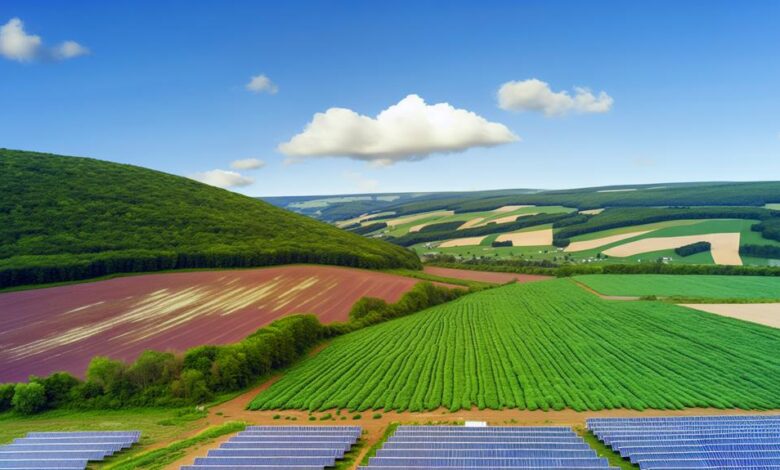Pennsylvania Land Lease Rates for Solar Farms: What to Expect

When you’re considering leasing your land for a solar farm in Pennsylvania, it’s crucial to understand what influences lease rates, from land suitability to market demand and government incentives. You might be wondering how these factors translate into actual dollar amounts and what kind of financial benefits you can expect. Lease rates in prime rural locations range between $700 and $1,200 per acre annually, but there’s more to the story. How do escalation clauses and revenue-sharing models come into play? And what about the long-term stability and tax benefits? Let’s explore these aspects to help you make an informed decision.
Factors Influencing Lease Rates
Several critical factors influence Pennsylvania land lease rates for solar farms. Firstly, land suitability plays a significant role. You need to assess soil quality, topography, and solar exposure. Ideal land for solar farms is flat and receives ample sunlight, which can command higher lease rates.
Next, consider competition. With increasing interest in renewable energy, more developers are eyeing potential sites, driving up lease rates. If your property is in a high-demand area, you can negotiate better terms.
Landowner negotiations are another crucial factor. Effective communication and understanding market rates are essential to secure favorable lease agreements. Don’t hesitate to consult with experts and conduct thorough research to understand what similar properties are getting.
Property size also impacts lease rates. Larger properties offer economies of scale, making them more attractive to developers. If you own a substantial amount of land, you’re in a stronger negotiating position. Conversely, smaller parcels might need to be competitively priced to attract interest.
Current Market Trends
Current market trends for solar farm lease rates in Pennsylvania reveal a dynamic and competitive landscape. Market demand for renewable energy has surged, driving a significant uptick in lease rate negotiations. With increasing interest from solar developers, landowners are finding themselves in a favorable position during lease rate negotiations.
A competitive landscape analysis indicates that lease rates vary significantly based on location, land quality, and proximity to electrical infrastructure. Rural areas with high solar irradiance and flat terrain are particularly in demand. In these prime locations, you can expect lease rates to range from $700 to $1,200 per acre annually.
Market demand is also influenced by state incentives and federal tax credits, which make solar projects more financially viable. This heightened demand is causing more robust landowner negotiations, where terms can be more favorable compared to other states with less aggressive renewable energy goals.
For precise lease rate negotiations, it’s crucial to stay informed about current market conditions and comparable lease agreements in your area. This data-driven approach will help you maximize the value of your land lease and stay competitive in Pennsylvania’s evolving solar market.
Financial Benefits for Landowners
When leasing your land for solar farms, the financial benefits can be substantial. You’ll typically receive a steady income stream, offering long term stability compared to traditional agriculture.
Lease rates in Pennsylvania can range from $500 to $1,500 per acre annually, depending on site-specific factors. Moreover, land improvement often occurs as companies maintain the land to maximize efficiency, potentially increasing your property’s value.
However, it’s crucial to consider the tax implications. Lease income is taxable, but certain expenses related to land maintenance might be deductible. Consulting with a tax advisor ensures you leverage any available tax benefits.
Effective negotiation strategies are vital in securing favorable terms. Start by understanding the market rates and the financial health of the leasing company.
Be prepared to negotiate escalation clauses to ensure income keeps pace with inflation over the lease term. Additionally, explore options for revenue-sharing models which may provide higher returns based on the farm’s energy production.
Lease Agreement Terms
A well-crafted lease agreement is pivotal to maximizing the benefits of leasing your land for solar farms. During lease negotiation, you’ll need to consider several critical components to ensure the contract is mutually beneficial.
One of the foremost aspects to scrutinize is the contract length. Typically, solar farm leases range from 20 to 30 years, reflecting the long-term nature of solar energy projects. This extended duration ensures stability for both parties but requires careful planning to account for potential changes in land value and usage.
You should also be vigilant about financial terms, such as annual lease payments and escalation clauses. Data indicates that Pennsylvania landowners can expect lease rates ranging from $500 to $1,500 per acre per year. However, these rates may vary based on location, land quality, and market demand. Including periodic reviews and adjustments in your lease agreement can help keep the terms fair over time.
Additionally, it’s crucial to address land maintenance responsibilities, liability clauses, and decommissioning plans. A comprehensive agreement will protect your interests and provide a clear framework for the solar developer.
Future Outlook and Projections
As Pennsylvania continues to embrace renewable energy, the future outlook for solar farm land leases looks promising. You can expect lease rates to be influenced by several key factors.
First, solar technology advancements are driving down the cost of solar panel installations. Improved efficiency and reduced costs mean developers can offer competitive lease rates while maintaining profitability.
Additionally, the growing competition among developers will likely benefit landowners. More players in the market create a competitive environment, pushing lease rates higher as developers vie for prime locations.
According to recent industry data, lease rates in Pennsylvania could see an annual increase of 3-5% over the next decade due to this heightened demand.
Furthermore, state and federal incentives aimed at promoting renewable energy will continue to play a significant role. Programs like the Solar Investment Tax Credit (ITC) and Pennsylvania’s Alternative Energy Portfolio Standards (AEPS) are expected to remain influential, encouraging more solar projects and potentially driving up lease rates.
Conclusion
In summary, Pennsylvania’s solar farm land lease rates are shaped by land quality, market demand, and incentives, offering landowners $700 to $1,200 per acre annually. While some might worry about market volatility, the steady 3-5% annual increase and robust lease terms ensure reliable income. You’ll benefit from tax incentives and long-term stability. As solar technology advances, expect even more lucrative opportunities. Embrace this sustainable investment for a brighter financial future.



